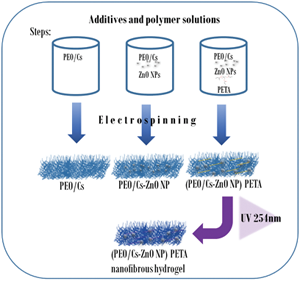Crossref Citations
This article has been cited by the following publications. This list is generated based on data provided by
Crossref.
Bagheri, Mitra
Validi, Majid
Gholipour, Abolfazl
Makvandi, Pooyan
and
Sharifi, Esmaeel
2022.
Chitosan nanofiber biocomposites for potential wound healing applications: Antioxidant activity with synergic antibacterial effect.
Bioengineering & Translational Medicine,
Vol. 7,
Issue. 1,
Siddiqui, Nadeem
Karthik, Kotikalapudi
Adapala, Monica
Renuka, Vemparala
Yashwanth, Goudu
and
Golamar, Siva Reddy
2022.
A Review On Electropsun Chitosan Fibers For Bone Tissue Defects.
International Journal of Life Science and Pharma Research,
Rodriguez, Cristobal
Padilla, Victoria
Lozano, Karen
Ahmad, Fariha
Chapa, Alejandra
Villarreal, Alexa
McDonald, Andrew
Materon, Luis
and
Gilkerson, Robert
2022.
Cell proliferative properties of Forcespinning® nopal composite nanofibers.
Journal of Bioactive and Compatible Polymers,
Vol. 37,
Issue. 1,
p.
28.
Argueta-Figueroa, Liliana
Jurado, Carlos Alberto
Torres-Rosas, Rafael
Bautista-Hernández, Mario Alberto
Alhotan, Abdulaziz
and
Nurrohman, Hamid
2022.
Clinical Efficacy of Biomimetic Bioactive Biomaterials for Dental Pulp Capping: A Systematic Review and Meta-Analysis.
Biomimetics,
Vol. 7,
Issue. 4,
p.
211.
Younes, Husam
Kadavil, Hana
Ismail, Hesham
Adib, Sandi
Zamani, Somayeh
Alany, Raid
and
Al-Kinani, Ali
2023.
Overview of Tissue Engineering and Drug Delivery Applications of Reactive Electrospinning and Crosslinking Techniques of Polymeric Nanofibers with Highlights on Their Biocompatibility Testing and Regulatory Aspects.
Pharmaceutics,
Vol. 16,
Issue. 1,
p.
32.
Sathiyaseelan, Anbazhagan
Vishven Naveen, Kumar
Zhang, Xin
Han, Kiseok
and
Wang, Myeong-Hyeon
2023.
Research progress on chitosan-zinc oxide nanocomposites fabrication, characterization, biomedical and environmental applications.
Coordination Chemistry Reviews,
Vol. 496,
Issue. ,
p.
215398.
Kamanna, Kantharaju
Amaregouda, Yamanappagouda
and
N, Mahesh Kumar
2023.
Chitosan/polyvinyl alcohol-based nanocomposite films incorporated with L-Glu surface functionalized ZnO NPs: Physicochemical, photocatalytic, antimicrobial and antioxidant properties evaluation.
Environmental Nanotechnology, Monitoring & Management,
Vol. 20,
Issue. ,
p.
100861.
Hinane Baleh
Dehbi, Abdelkader
Benhaoua, Chahrazed
Zidane, Khaled
Alsalme, Ali
and
Messori, Massimo
2024.
Synthesis, Characterization, and Antimicrobial Evaluation of Poly(benzaldehyde-co-thiophene)/Zinc Oxide (PBT/ZnO) Composites for Potential Applications.
Polymer Science, Series B,
Vol. 66,
Issue. 1,
p.
97.
Khan, M. Nuruzzaman
Arafat, M. Tarik
Rashid, Taslim Ur
Haque, Papia
and
Rahman, Mohammed Mizanur
2024.
RETRACTED: Chitosan-Stabilized CuO Nanostructure-Functionalized UV-Crosslinked PVA/Chitosan Electrospun Membrane as Enhanced Wound Dressing.
ACS Applied Bio Materials,
Vol. 7,
Issue. 2,
p.
961.
Tayebi, Leila
Mahboubi, Arash
Bayat, Fereshteh
Moayeri-Jolandan, Sina
and
Haeri, Azadeh
2024.
Photo-Cross-Linked Nanofibers Containing Melissa Officinalis Extract as a Novel Active Food Packaging: An Eco-Friendly Alternative for Plastic Packaging.
Journal of Polymers and the Environment,
Vol. 32,
Issue. 9,
p.
4385.
Kharat, Zahra
Azarnia, Maliheh
Ranjbar, Parviz Rashidi
and
Kabiri, Mahboubeh
2025.
Curcumin-encapsulated Pluronic micelles in chitosan/PEO nanofibers: a controlled release strategy for wound healing applications.
Journal of Polymer Engineering,
Vol. 45,
Issue. 3,
p.
256.
Altynov, Yerkebulan
Bexeitova, Kalampyr
Nazhipkyzy, Meruyert
Azat, Seitkhan
Konarov, Aishuak
Rakhman, Damira
Sahiner, Nurettin
and
Kudaibergenov, Kenes
2025.
Nanocellulose hydrogels from agricultural wastes: methods, properties, and application prospects.
Nanoscale,
Vol. 17,
Issue. 20,
p.
12580.
